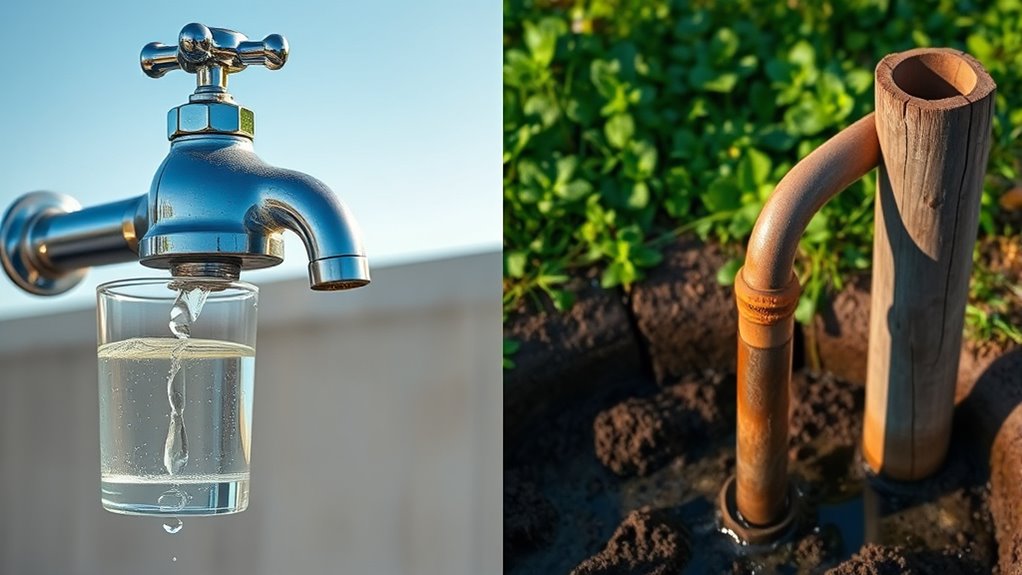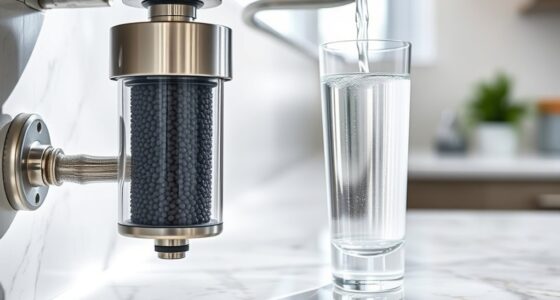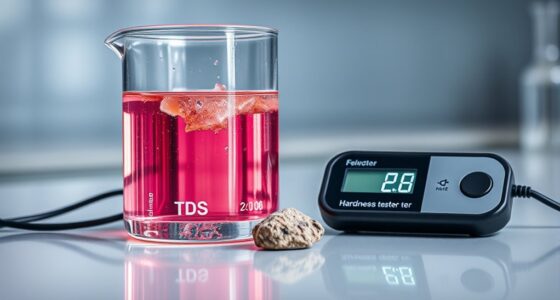Municipal water comes from a central treatment facility that supplies your home through a network of pipes, ensuring water is safe and regulated. Well water is collected directly from underground sources and needs regular testing and maintenance to stay safe. While municipal water often has added chemicals like chlorine, well water can have natural minerals or contaminants. Understanding these differences helps you choose the best option, and there’s more to learn about how each source impacts your water quality.
Key Takeaways
- Municipal water is centrally treated and tested regularly for safety, while well water is collected from underground sources and requires individual testing.
- Municipal systems are maintained by authorities, whereas well owners are responsible for their own well upkeep and water quality.
- Well water may contain higher natural minerals or pollutants without treatment, unlike municipal water which is filtered and disinfected.
- Installing a well usually involves higher initial costs, while municipal water connection is generally cheaper upfront.
- Municipal water offers a reliable supply with regulated quality, but well water provides independence and potential cost savings over time.
What Is Municipal Water and How Is It Supplied?
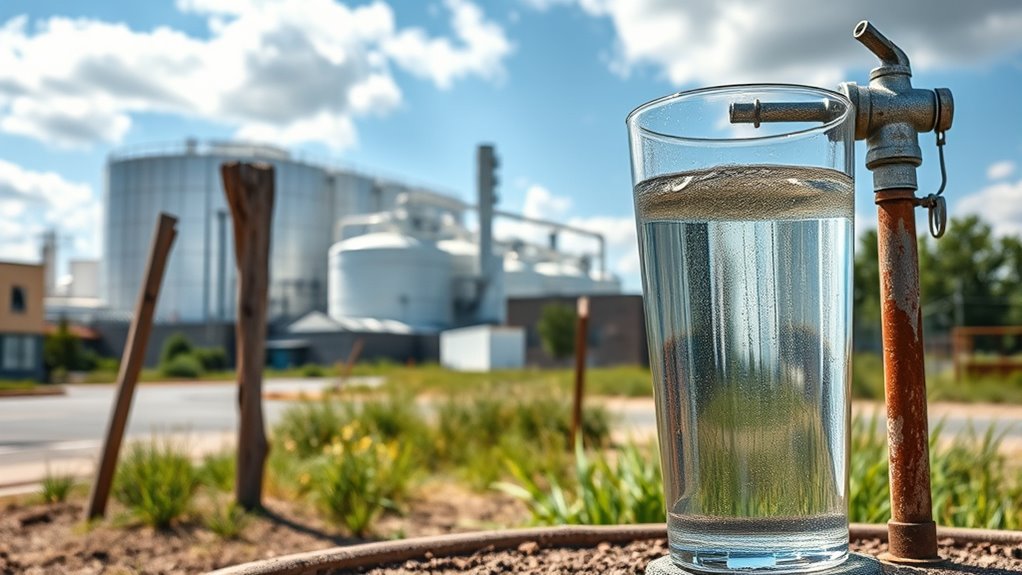
Municipal water is the supply you get from your local government or water utility. It’s treated at a central facility to guarantee safety and quality. Water filtration is a key step, removing contaminants before it reaches your home. Once treated, the water travels through an extensive plumbing infrastructure, including pipes and pumps, to reach your tap. This system is designed to deliver clean, safe drinking water reliably. The infrastructure is maintained and upgraded regularly by local authorities to prevent leaks and ensure consistent pressure. Because of this, municipal water often requires less personal filtration or treatment. Your local utility aims to provide a steady, safe supply, but understanding how the plumbing infrastructure works can help you troubleshoot issues or decide if additional water filtration is needed at your home. Regular inspections can reveal issues like leaks or pressure problems, which might impact water quality or supply.
How Well Water Is Collected and Managed
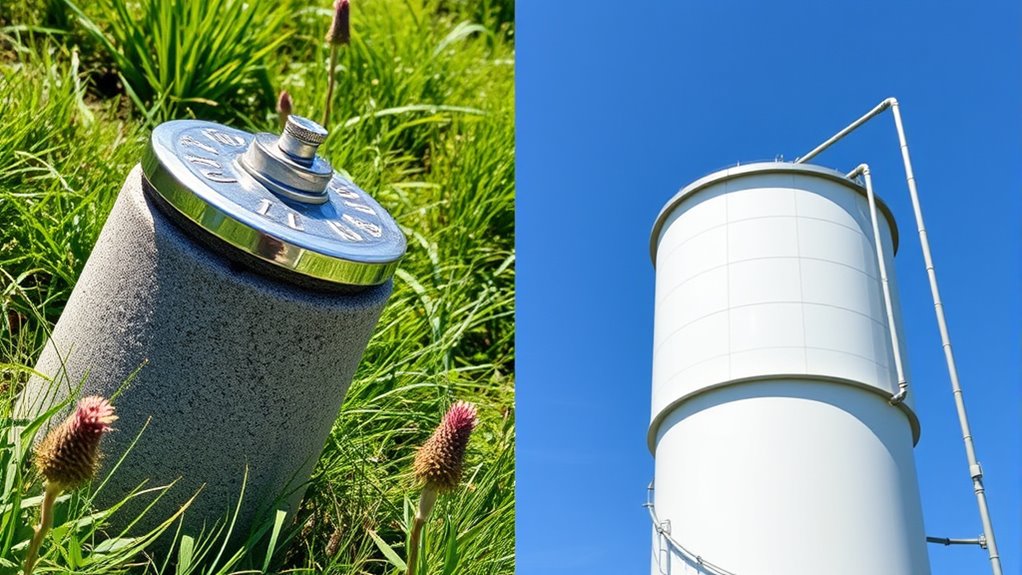
Well water is collected directly from underground aquifers through drilled or dug wells, which serve as the primary source. Water collection involves carefully drilling or excavating to reach clean, accessible underground sources. Once collected, managing this water requires regular monitoring and maintenance to guarantee quality and safety. Management techniques include installing proper pumps, pressure tanks, and filtration systems to prevent contamination and maintain consistent flow. You should also regularly test your well water for impurities and keep records of maintenance activities. Protecting the well from surface runoff, chemicals, and debris is essential to prevent pollution. Proper management ensures your well water remains safe, reliable, and sustainable for everyday use. Additionally, implementing water quality testing procedures is vital to identify potential contaminants early. Staying proactive about water collection and management keeps your well functioning efficiently.
Differences in Water Quality and Safety Standards
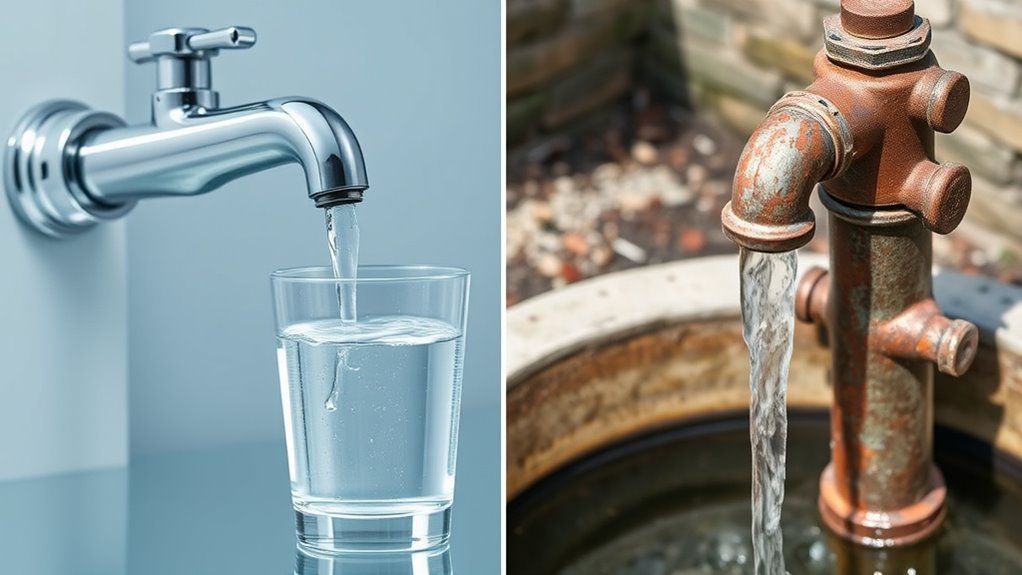
You’ll notice that municipal water and well water are held to different safety standards, which affects how often they’re tested and what contaminants are monitored. Municipal systems must meet strict regulatory requirements, while private well owners are responsible for their own testing. Understanding these differences helps you decide how to guarantee your water remains safe to use. Additionally, knowledgeable homeowners can implement whole-house water filtration systems to address specific water quality concerns and ensure consistently clean water throughout their homes.
Regulatory Standards Comparison
While both municipal and well water are subject to safety standards, the regulations governing them differ considerably. Municipal water must meet strict federal and state guidelines, including regular water treatment and infrastructure maintenance. Well water, however, is typically regulated less stringently, often requiring testing by homeowners rather than enforced oversight. The table below compares key standards:
| Aspect | Municipal Water | Well Water | Regulatory Focus |
|---|---|---|---|
| Water Treatment | Mandatory treatment facilities | Varies; homeowner responsible | Ensuring safety and potability |
| Infrastructure | Regular maintenance & upgrades | No centralized system | Preventing contamination |
| Testing Frequency | Periodic testing by authorities | Owner-conducted testing | Detecting contaminants early |
Additionally, the regulatory oversight for municipal water generally includes periodic monitoring for a wide range of potential contaminants, whereas well water testing is often less frequent and more dependent on individual actions.
Contaminant Levels Variance
Contaminant levels in municipal and well water can vary markedly due to differences in treatment practices, source quality, and regulation enforcement. Because of this, you might notice fluctuations in water safety and purity. Variations happen because:
- Some municipal systems use advanced water treatment to remove contaminants effectively.
- Well water may contain higher levels of naturally occurring minerals or pollutants.
- Contaminant detection depends on testing methods, which can miss certain pollutants.
- Regulations influence how strictly water sources are monitored and maintained.
- The presence of natural materials like stone can also affect water composition in well systems.
These differences mean you should be aware that water quality isn’t consistent across sources. Regular testing helps identify contaminant levels and guarantees water safety, whether you rely on municipal supplies or a private well. Water treatment plays a vital role in managing the variance in water quality.
Testing Frequency Differences
Because contaminant levels can fluctuate based on testing practices and regulatory oversight, the frequency of water testing critically affects water safety. Municipal water supplies are typically tested more often, ensuring issues like chlorine residuals and pH levels stay within safe ranges. Regular testing helps detect changes in chlorine residuals, which are essential for disinfecting water, and pH levels that affect water stability and corrosion. Well water, on the other hand, often undergoes less frequent testing, increasing the risk of unnoticed contamination or chemical imbalances. Without consistent testing, contaminants or pH shifts can go undetected, compromising safety. Additionally, the type of water technology used, such as color accuracy in projectors, can influence how well water quality information is interpreted and presented. As a result, understanding testing frequency helps you gauge how well water quality is maintained and when you might need to perform additional testing or treatment to ensure safe drinking water.
Cost Comparison Between Municipal and Well Water

When comparing costs, you’ll want to consider both upfront installation expenses and long-term expenses for maintenance and water bills. Municipal water usually has higher initial costs due to infrastructure connections, but it often costs less over time. Well water might save you money at first, but maintenance and testing can add up over the years. Additionally, water quality management is essential for well water to ensure safety and compliance.
Upfront Installation Expenses
Are you wondering which water source requires a bigger initial investment? The installation costs for municipal water are usually lower because you connect to existing infrastructure, but there are still expenses to weigh up. Well water installation involves more upfront work and higher initial investment, especially if drilling equipment is needed. Here’s a quick breakdown of what to expect:
- Drilling a well and installing a pump system
- Filtration and water treatment setup
- Electrical wiring and plumbing connections
- Permits and inspections
- Advanced fraud detection techniques to ensure payment security during installation financing can also play a role in managing overall project costs.
Well water systems often have higher upfront costs due to drilling and equipment, while municipal connections tend to be more affordable initially. Your choice depends on how much you’re willing to invest at the start versus ongoing costs.
Long-term Cost Differences
While initial installation costs differ, it’s important to contemplate how the ongoing expenses stack up over time. Municipal water typically has higher pricing differences due to infrastructure costs and regular service fees, but these are predictable and often include maintenance. Well water usually costs less month-to-month since you’re responsible for the well and pump maintenance, but unexpected repairs can add up. Over the long term, well owners may save money on water bills, but they might face higher costs for repairs or water treatment. Additionally, water quality concerns can influence maintenance needs and overall expenses. Over time, municipal water’s steady monthly charges can feel more predictable, although they tend to be higher overall. Ultimately, your long-term costs hinge on local rates, infrastructure expenses, and how well-maintained your water source remains over time.
Maintenance and Testing Responsibilities
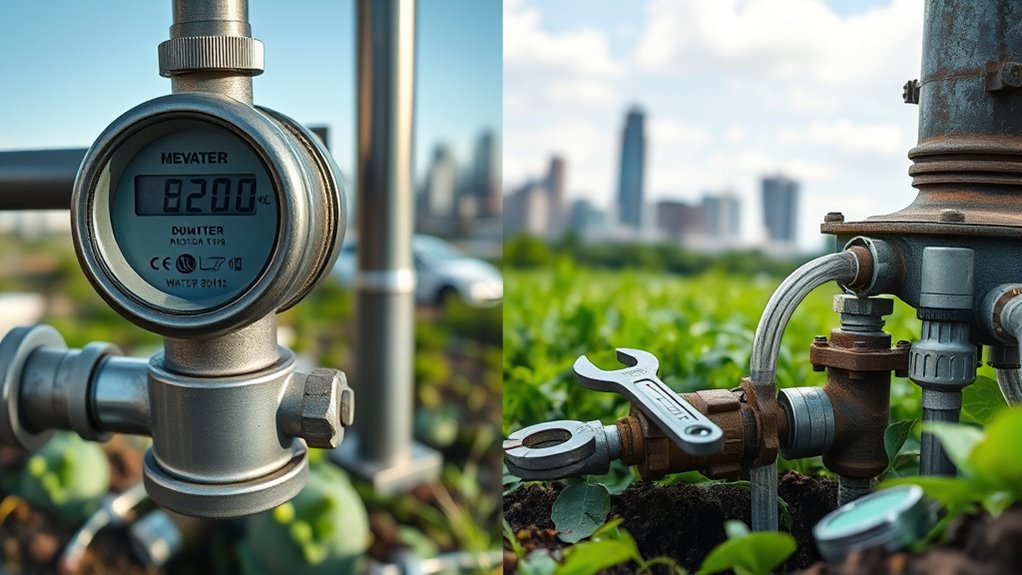
Maintaining your water supply system and conducting regular tests are essential to guarantee safe and reliable water quality. You need to stay on top of disinfection challenges and pipe maintenance to prevent issues. Regular testing helps identify contaminants early, while proper maintenance ensures pipes stay clear and functional. Monitoring filtration systems is also crucial to ensure allergens and fine dust are effectively captured. Keep detailed records of tests and maintenance activities.
Potential Contaminants and Health Risks
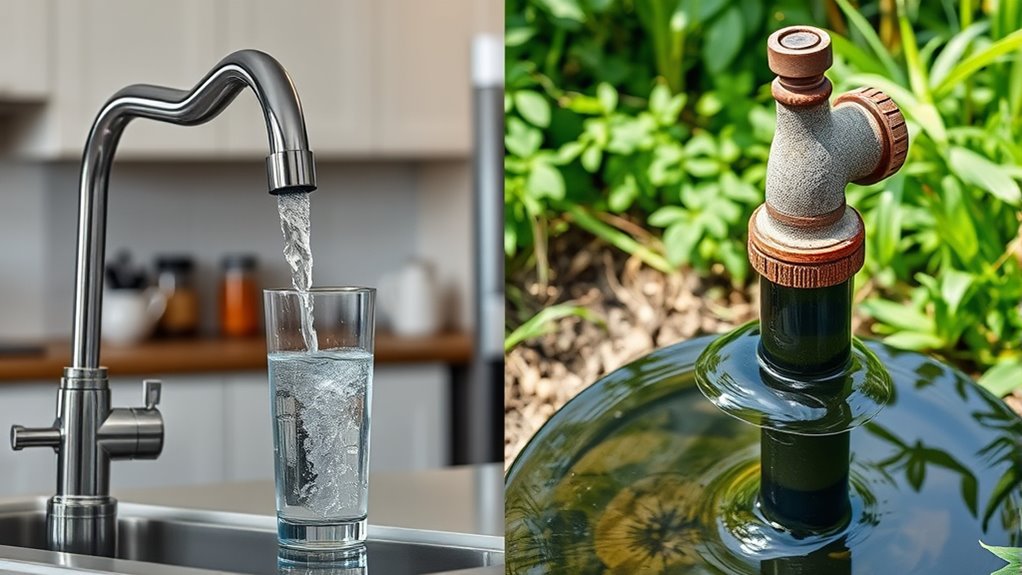
Understanding potential contaminants in your water is essential because they can pose serious health risks if left unchecked. Pesticide residues from agricultural runoff can seep into well water, exposing you to chemicals linked to long-term health issues. Microbial contamination, such as bacteria, viruses, and parasites, can enter both municipal and well water sources, leading to illnesses like gastrointestinal infections. Well water is particularly vulnerable if not regularly tested, as it’s more exposed to environmental factors. Even municipal water, which is treated, can sometimes contain traces of pesticides or microbial residues if the treatment process isn’t thorough or if contamination occurs after treatment. Staying aware of these risks encourages regular testing and proper filtration to protect your health.
Advantages and Disadvantages of Each Water Source

Both municipal and well water have unique advantages and disadvantages that can influence your choice depending on your needs and circumstances. Municipal water offers consistent supply reliability and is usually treated to address filtration challenges, ensuring safe drinking water. However, it can contain additives like chlorine, which some prefer to avoid. Well water, on the other hand, provides independence and potentially better taste but depends heavily on your local water table, making supply reliability an issue during droughts or dry seasons. You’re also responsible for maintaining filtration systems to remove contaminants. Additionally, well water may require more frequent testing and treatment to ensure safety. Understanding these pros and cons helps you decide which source best fits your lifestyle and health priorities.
Making the Right Choice for Your Home
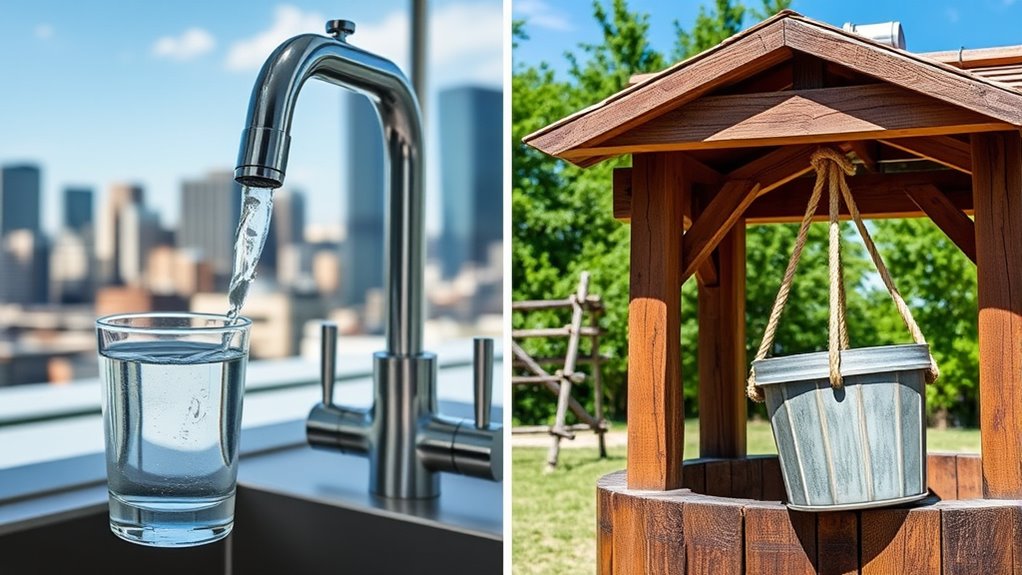
Choosing the right water source for your home depends on several factors, including your location, budget, health concerns, and personal preferences. If you opt for municipal water, you’re benefiting from regulated water treatment and regular infrastructure maintenance, but you rely on community systems. Well water offers independence but requires you to handle your own water treatment and maintenance. Consider these aspects:
| Aspect | Municipal Water | Well Water | Your Choice |
|---|---|---|---|
| Water Treatment | Usually treated and safe | Needs personal treatment | Choose based on water quality |
| Infrastructure | Maintained by the city | Your responsibility | Consider your ability to maintain |
| Cost | Often included in taxes | Usually lower upfront | Balance initial cost and ongoing care |
Frequently Asked Questions
How Often Should I Test My Well Water for Contaminants?
You should test your well water at least once a year for contamination indicators. Regular well water testing helps catch potential issues early, especially for bacteria, nitrates, and other pollutants. If you notice changes in taste, smell, or appearance, test immediately. Also, after heavy rainfall or nearby construction, it’s wise to evaluate more frequently. Staying proactive ensures your water remains safe and healthy for your household.
Can Municipal Water Become Contaminated During Delivery?
Think of municipal water as a delicate ribbon flowing through a tightrope—while it’s treated, water delivery risks mean contamination can still creep in. Yes, municipal water can become contaminated during delivery, exposing you to potential municipal contamination. Infrastructure breaks, pipe leaks, or cross-connections can introduce pollutants. Stay vigilant, regularly check your water quality, and consider home filtration to guard against unseen threats that might threaten your health.
Are There Legal Regulations for Private Well Construction?
Yes, there are legal regulations for private well construction. You need to obtain well permits before drilling, ensuring your well meets regulatory standards for safety and water quality. These standards typically cover well location, construction materials, and proper sealing to prevent contamination. Local or state agencies enforce these rules, so check with your authorities to make sure your well construction complies with all legal requirements and protects your water supply.
How Does Water Taste Differ Between Municipal and Well Sources?
You’ll notice that municipal water often has a more neutral taste, thanks to added treatments and disinfectants, while well water can have a richer flavor due to higher mineral content. The taste profiles differ because well water usually contains more natural minerals like calcium and magnesium, giving it a distinctive, sometimes earthy or metallic flavor. Your personal preference might depend on whether you favor the cleaner taste of municipal water or the mineral-rich flavor of well water.
What Are the Environmental Impacts of Each Water Source?
Think of your water source as a delicate balance scale. Municipal water often faces industrial pollution, risking contamination, while well water can deplete groundwater reserves, causing long-term environmental strain. Both impact ecosystems—municipal treatment might introduce chemicals, and well extraction can lead to depletion and land subsidence. By choosing your water source wisely, you help protect these essential resources, ensuring they remain sustainable for future generations.
Conclusion
Choosing between municipal and well water isn’t a decision to take lightly. Weigh the quality, costs, and maintenance involved to find what suits your needs best. Remember, it’s better to be safe than sorry, so don’t cut corners when it comes to water testing and treatment. By doing your homework, you can guarantee your home’s water is safe and reliable—after all, you don’t want to be caught with your pants down when it comes to your health.
